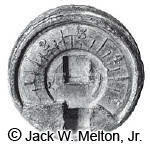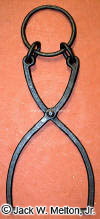.



 It was made of hinged sheet brass with steel points. A graduated scale along
the side was set up in inches and divisions.
It was made of hinged sheet brass with steel points. A graduated scale along
the side was set up in inches and divisions.FUZE REAMER: The implement used to enlarge the hole in a fuze-plug so as to make it of the proper size for the paper fuze.
FUZE SETTER: An implement for setting wooden fuzes in the fuze-hole. It is made of brass; the bottom is countersunk and cup-shaped, to prevent it from slipping off from the head of the fuze.
FUZE-WRENCH: A three pronged wrench used for setting fuze-plugs that are to be screwed into the shell. One prong contains forks for the fuze-plug, and another one smaller forks for the water-cap.
FUZE AUGER: A tool used to reduce the length of the powder composition column in a paper time fuze after it had been set in the projectile. The auger consisted of a bit which fit inside a graduated slider scale. The bit was set to the appropriate depth according to the slider. The auger then forced the bit into the fuze and removed the powder.
FUZE CUTTER: Also known as fuze punch or fuze gouge. A steel chisel, with a brass or wooden handle designed for cutting into the powder train in a Bormann time fuze
FUZE EXTRACTOR: Also known to artillerists as a Fuze Engine. It was used to remove fuzes from the wooden fuze holders when they had been driven in too far. The inner screw and its stem were made of steel and riveted into the iron handle. The stem was contained in a hollow screw of steel which was worked up and down by means of an iron nut with two handles. The bottom of the frame was placed over the fuze head and the inner screw was twisted into the fuze by means of the upper handle. The handles of the nut were then turned and the screw bit into the fuze and twisted it out.
FUZE MALLET: A wooden hammer made of one solid piece of dogwood or oak. It was used to drive fuzes and fuze plugs into projectiles.
FUZE REAMER: An implement used to enlarge the hole in a fuze plug for proper fitting of the plug.
FUZE SAW: A small saw, with a 10-inch iron blade, used to cut wooden
fuzes to the desired length.


FUZE SETTER: A brass cylinder 5- to 6-inches in length and 2-inches in diameter. It was used to seat a wooden fuze holder into the fuze hole of a shell.
GUNNERíS PINCHERS: A steel pair of jaws with iron handles used for
grasping and removing any debris that extended above the vent. A nail puller
was forged into the end of one handle. The photograph below is not a
period gunner's pinchers but is for an example of what they look like.
![]()
LOADING TONG: Used for inserting the powder cartridge and projectile into mortars and other large weapons.
 Tongs were formed of two arms hinged together so that the bent ends of the
short arms entered the ears of the projectile, while the widened and grooved
ends of the long arms could carry the cartridge.
Tongs were formed of two arms hinged together so that the bent ends of the
short arms entered the ears of the projectile, while the widened and grooved
ends of the long arms could carry the cartridge.
VENT PUNCH: A tool for clearing the vent of any obstructions.